 See why 4thWay now accepts ethical ads.
See why 4thWay now accepts ethical ads.
Spreading The Risk Across Eight Different Types Of Lending
The majority of peer-to-peer and online lending focuses on development lending. That sector has gone through a very rough patch in recent years and I've been wondering whether too many individual lenders have not spread across other types of lending.
So it's a good time to reassess whether you have taken sufficient steps not just to lend across the minimum 6+ lending accounts, but also across enough types of lending.
The point is to ensure maximum stability in a type of investment that has shown extraordinary resilience in the face of multiple downturns and even sector-specific shocks.
I count a surprising eight broad lending types that 4thWay's specialists track! I've numbered this list for convenience, but it's not some sort of ranking system:
1. Residential buy-to-let (BTL) lending
It's not easy to lend to landlords through P2P and other online direct lending providers and these opportunities come and go, but there's usually some activity going on in this space at any one time.
Typically, the interest you earn here can be around 5% to 7%.
Risks in lending to BTL landlords include bad debts due to a rise in borrowing rates, which is a huge cost to landlords. It also includes rising prices of materials and other expenses. These can impact maintenance costs; for example, Towergate Insurance found they had risen 26% in the two years to 2024.
There are huge mitigants to the risk of lending to landlords. Firstly, they are usually already renting their properties out when you start lending, and so the properties are self-sustaining for the landlords and therefore to potential lenders like you.
There's also a huge shortage of residential properties in the UK and this shortfall has increased every year for decades now. This helps landlords continue to charge well for rent and means most will never be short of potential tenants. It also means that property prices are generally well supported.
Right now, the only option 4thWay knows of that is big in this space is Housemartin* (read Review), which actually offers a kind of hybrid between lending and sort-of-ownership, as you can share in the profits if or when the properties are sold.
2. Commercial buy-to-let lending
Commercial premises being rented out are technically better known as commercial-investment properties: But it's basically BTL with offices, warehouses, shops, hotels and more being rented out instead of houses and flats.
You can earn sort of 6% to 10% in this space. More than in residential BTL lending, because assessing the risk of each borrower or property is harder and because there's no huge shortage of commercial properties like there is for homes.
You need to lend to a variety of different types of businesses, because any one sector can suffer its own issues that suddenly make it hard for tenants in the properties to pay the landlords, who in turn will default on their loans to you.
Unlike BTL lending, commercial-property landlords can relatively easily kick out their tenants if they fail to pay, although it's not a back-stop you really want to go to and it's not always easy to find replacement tenants.
You generally only start lending to the landlords when the properties already have tenants, which helps contain the risks.
The provider that 4thWay's specialists have sufficient access to for evaluating is Proplend* (read Review).
3. Senior development lending
We need to split development lending between senior and junior, as they are very different.
Here, you're lending to property developers and those developers are required to pay you back first if they struggle to pay all their debts, even if they have also borrowed from others. Rates can be between about 6% and 12%.
A key risk here is that assessing and approving development loans, and dealing with issues when a development falls behind, is just about the most difficult of all lending.
It's highly specialised, and it requires skill, experience and discipline to get right. Otherwise, you could end up with a half-completed development that is hard to dispose of for the amount borrowed so far, which can exceed the initial starting value of the land and property.
Recent history nicely shows some of the risks here. As a colleague wrote today:
“There was an exodus of skilled construction workers as the impact of Brexit eventually started to hit, which was then greatly exacerbated by the pandemic. Supply chains got destroyed and high inflation hit the cost of construction materials. Then, in autumn 2022, interest rates shot up, which stamped on property-buyer demand, and developers are taking longer to sell out.”
The main mitigant to risk is not lending too much to the borrowers. The masters in that field are Loanpad* (read Review).
4. Junior development lending
This is also lending to property developers, but you are taking the riskiest slices of the loans. That's why you typically earn 10% to 20%, depending largely on the characteristics of each specific loan.
Here's a simplified example. Let's say that a senior lender lends 55% of the hoped-for sale price of the completed development and you lend the next 20%. If the property is ultimately sold at 35% below the expected price, you'll lose half your loan, while the senior lenders will be untouched.
Aside from that, the risks are rather like senior development lending, but where you know every single loan has a stretched risk. One of the main mitigants to the risks is simply charging high enough rates to make up for some losses.
The provider most focused on this space that 4thWay currently covers is CapitalStackers* (read Review).
5. Short-term property lending
Paying between 7% and 12%, this is technically called bridging lending. That's a bit of a misnomer.
A “bridge” usually means that someone is selling one property and buying another, but needs a temporary large loan to buy the new property now, because the old property is not yet sold.
In reality, a lot of bridging loans are just short-term property loans for other reasons. For example, the property owner is not yet ready or able to put a tenant in a property and get a regular mortgage, so takes out a short-term loan (at higher cost).
The risks here are that the property owners are often in a less secure place than a property owner who is able to take out a regular mortgage against a tenanted property.
Still, there are a huge number of different reasons why people take out bridging loans, so there's a lot of diversification among the borrowers and their properties.
The main mitigant, as with development lending, is to lend substantially less than the borrower's property is worth.
The premium lender focused exclusively on bridging that 4thWay currently cover is called Somo* (read Review).
6. Property-secured business lending
It's not just landlords that take out loans secured on real property. Other businesses of all types do too.
Small and medium-sized businesses don't always take out regular bank loans but instead do property-secured, as it enables them to borrow more or at lower rates. Still, you might be earning around 8.5% to 11%.
Any major hit to the economy can impact a lot of businesses, which is a risk. However, similar to bridging, these businesses can be very different from one another, which adds diversification within your portfolio.
The largest P2P lending provider in the UK does property-secured business lending. That is FOLK2FOLK (read Review).
7. Unsecured personal lending
So far, we've covered secured lending only – and all of it secured on real property, aka real estate. Now we come to unsecured personal lending, which can pay lenders 5% to 10% – or a lot more if you go down the path of payday P2P lending.
Any major downturn can cause sufficient numbers of people to struggle enough that you'll see bad debts rise in your portfolio.
While technically an unsecured loan can be turned into a secured one by the courts when people default on their debts (and often is), in practice you still expect to lose a fair bit on each loan that goes bad.
This is why you need to lend to a very large number of borrowers to contain the risks and keep lending through good and bad years.
The provider that does the most “normalish” personal loans at present is Lendwise (read Review), although its take is rather interesting.
8. Unsecured or loosely secured business lending
Finally, there's lending to businesses who don't secure their loans on real property. You're maybe looking at 8% to even 15% here.
When you lend to small businesses and you're not securing those loans on real property, you might lend either completely unsecured or more loosely secured on whatever cash or other assets the business happens to have left when it goes bust.
This is a tricky space that requires a lot of skill for the people who are assessing the borrowers and deciding whether to approve the loans, and what interest rates to set.
In a major downturn, these kinds of loans often get hit hard, which is why the interest rates set are just as key as the initial assessment of the borrower.
4thWay has not been able to update you much on these options for a while, but our specialists have recently achieved a lot more access to both Rebuildingsociety and Crowd2Fund, so hopefully you'll get more on both of those soon.
Pages linked to above
Independent opinion: 4thWay will help you to identify your options and narrow down your choices. We suggest what you could do, but we won't tell you what to do or where to lend; the decision is yours. We are responsible for the accuracy and quality of the information we provide, but not for any decision you make based on it. The material is for general information and education purposes only.
We are not financial, legal or tax advisors, which means that we don't offer advice or recommendations based on your circumstances and goals.
The opinions expressed are those of the author(s) and not held by 4thWay. 4thWay is not regulated by ESMA or the FCA. All the specialists and researchers who conduct research and write articles for 4thWay are subject to 4thWay's Editorial Code of Practice. For more, please see 4thWay's terms and conditions.
*Commission, fees and impartial research: our service is free to you. 4thWay shows dozens of P2P lending accounts in our accurate comparison tables and we add new ones as they make it through our listing process. We receive compensation from CapitalStackers, Housemartin, Loanpad, Proplend and Somo, and other P2P lending companies not mentioned above either when you click through from our website and open accounts with them, or to cover the costs of conducting our calculated stress tests and ratings assessments. We vigorously ensure that this doesn't affect our editorial independence. Read How we earn money fairly with your help.


